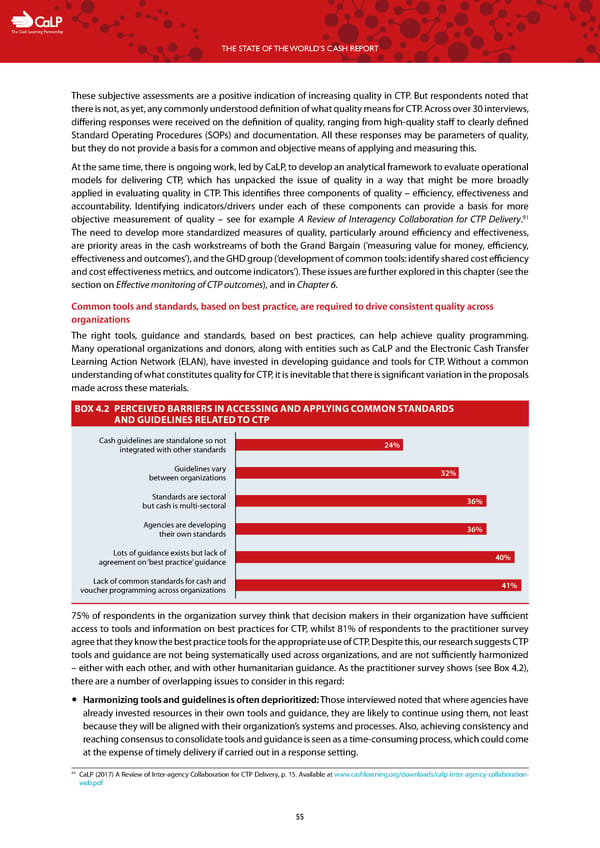C The Cash Learning Partnership THE STATE OF THE WORLD’S CASH REPORT These subjective assessments are a positive indication of increasing quality in CTP. But respondents noted that there is not, as yet, any commonly understood definition of what quality means for CTP. Across over 30 interviews, differing responses were received on the definition of quality, ranging from high-quality staff to clearly defined Standard Operating Procedures (SOPs) and documentation. All these responses may be parameters of quality, but they do not provide a basis for a common and objective means of applying and measuring this. At the same time, there is ongoing work, led by CaLP, to develop an analytical framework to evaluate operational models for delivering CTP, which has unpacked the issue of quality in a way that might be more broadly applied in evaluating quality in CTP. This identifies three components of quality – efficiency, effectiveness and accountability. Identifying indicators/drivers under each of these components can provide a basis for more 91 objective measurement of quality – see for example A Review of Interagency Collaboration for CTP Delivery. The need to develop more standardized measures of quality, particularly around efficiency and effectiveness, are priority areas in the cash workstreams of both the Grand Bargain (‘measuring value for money, efficiency, effectiveness and outcomes’), and the GHD group (‘development of common tools: identify shared cost efficiency and cost effectiveness metrics, and outcome indicators’). These issues are further explored in this chapter (see the section on Effective monitoring of CTP outcomes), and in Chapter 6. Common tools and standards, based on best practice, are required to drive consistent quality across organizations The right tools, guidance and standards, based on best practices, can help achieve quality programming. Many operational organizations and donors, along with entities such as CaLP and the Electronic Cash Transfer Learning Action Network (ELAN), have invested in developing guidance and tools for CTP. Without a common understanding of what constitutes quality for CTP, it is inevitable that there is significant variation in the proposals made across these materials. BOX 4.2 PERCEIVED BARRIERS IN ACCESSING AND APPLYING COMMON STANDARDS AND GUIDELINES RELATED TO CTP Cash guidelines are standalone so not 24% integrated with other standards Guidelines vary 32% between organizations Standards are sectoral 36% but cash is multi-sectoral Agencies are developing 36% their own standards Lots of guidance exists but lack of 40% agreement on ‘best practice’ guidance Lack of common standards for cash and 41% voucher programming across organizations 75% of respondents in the organization survey think that decision makers in their organization have sufficient access to tools and information on best practices for CTP, whilst 81% of respondents to the practitioner survey agree that they know the best practice tools for the appropriate use of CTP. Despite this, our research suggests CTP tools and guidance are not being systematically used across organizations, and are not sufficiently harmonized – either with each other, and with other humanitarian guidance. As the practitioner survey shows (see Box 4.2), there are a number of overlapping issues to consider in this regard: — Harmonizing tools and guidelines is often deprioritized: Those interviewed noted that where agencies have already invested resources in their own tools and guidance, they are likely to continue using them, not least because they will be aligned with their organization’s systems and processes. Also, achieving consistency and reaching consensus to consolidate tools and guidance is seen as a time-consuming process, which could come at the expense of timely delivery if carried out in a response setting. 91 CaLP (2017) A Review of Inter-agency Collaboration for CTP Delivery, p. 15. Available at www.cashlearning.org/downloads/calp-inter-agency-collaboration- web.pdf 55
 The State of the World's Cash | Full Report Page 56 Page 58
The State of the World's Cash | Full Report Page 56 Page 58